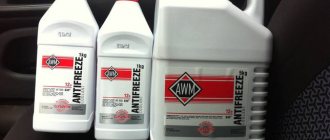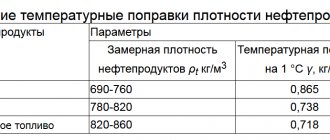In everyday life, quite often there is a need to convert liters of gasoline in stock into tons. Such calculations are necessary for internal use by employees of wholesale and retail stores. The information will be useful for accountants and storekeepers. And also to all those who work with fuel. They are used during receipt and decommissioning from the warehouse.
After all, the supplier usually supplies large containers of fuel, measured in tons. But drivers have to distribute and write off in much smaller quantities. A ton is a measure of weight, and liters is a measure of volume. The values are not equivalent, so calculations must be made. Converting gasoline to liters is quite simple.
How to convert liters to tons?
To calculate the mass of fuel, it is necessary to convert the formula used before.
We get: m=V* ρ, in our case: m=V*0.769/1000 (result in tons).
This formula uses the average value of fuel density established by the Ministry of Industry and Energy
Attention! Rostekhnadzor calculates the mass of fuel differently, taking separate values for each type of fuel. Thus, the density of diesel fuel is assumed to be 0.84 t/m3
Based on the above, we can conclude that in the warm season, due to the reduced density of the fuel, its volume will increase, and in the cold season it will decrease.
We hope that this method of converting from one measure to another will be useful to specialists whose duties involve maintaining fuel records. And to avoid fraud when accepting fuel, it is better to enter into an agreement with a reliable company.
Other articles:
Changes in the ruble program card service network:
Changes in the service network for liter and ruble program cards:
Changes in the ruble program card service network:
Sverdlovsk, Nizhny Novgorod, Chelyabinsk, Astrakhan regions, Krasnoyarsk, Khabarovsk territories.
AI95 from Rosneft is conquering the market
Rosneft's Ryazan refinery has exceeded the 1 million ton mark in the production of highly environmentally friendly Euro-6 gasoline.
New methane aromatization technology from Rosneft
Employees of the laboratory of NPK Rosneft have created the latest technology for methane aromatization.
Rosneft began production of motor oils of the highest technological line
The new Rosneft Magnum Racing motor oil for sports cars is a high-tech development from Rosneft.
By continuing to use ruspetrol.ru you agree to the use of cookies.
More information can be found in the Cookie Policy.
RusPetrol LLC, 2007-2020
Reproduction of site materials is permitted with the consent of the owner
His Majesty coefficient
How many liters are in one cube of water according to the meter?
For simplified and correct conversion, the Ministry of Industry and Energy of Russia made a truly Solomon-like decision to introduce fixed average density values for all types of liquid hydrocarbon fuels. Now accountants and all interested parties do not have to agonize over how to convert the number of liters of gasoline into tons. It is enough just to look at the corresponding table of coefficients and substitute the required value from there into the following formula: M = Vρ. It must be remembered that the result of such a simple calculation will be kilograms, which can only be converted into tons.
The coefficients for the most common and frequently used brands of gasoline are as follows:
- AI-80 = 0.715 g/cm3
- AI-92 = 0.735
- AI-95 = 0.75
- AI-98 = 0.765
- Diesel fuel – 0.769
In addition, Rostekhnadzor approved its own gradation of coefficients, according to which, for example, the specific density of diesel fuel is 0.84. This is the result of a double system of technical coordinates. It only remains to add that the actual density of the fuel can be measured independently with a special device - a hydrometer.
How do you know which number to put into the formula?
The Federal Tax Service of the Russian Federation, referring to the order of the Ministry of Energy, believes that the density of the fuel should be determined upon receipt of the fuel batch by measuring it with an oil densimeter - a special measuring device such as a hydrometer.
If the device is not available, then use the average density values of diesel fuel, which can be obtained from the local branch of Rostekhnadzor.
Gasoline conversion
The density of gasoline varies in the range of 0.70 kg/l - 0.78 kg/l.
When recalculating, the above formula is used, into which, in the absence of instrumental measurement of fuel density, the average value ρ is substituted:
- For AI-80 0.715 kg/l;
- AI-92 0.735 kg/l;
- AI-95 0.750 kg/l;
- AI-98 0.765 kg/l.
Conversion of kerosene
The density of kerosene varies, depending on the brand, in the range: 0.775 kg/l - 0.85 kg/l. Examples:
- lighting kerosene brand KO-30: density 0.790 kg/l;
- lighting kerosene brand KO-20: density 0.83 kg/l;
- Hydrogenated aviation kerosene for supersonic aircraft: density 840 kg/l. Etc.
Conversion of kerosene from liters to tons is carried out using the method described above after determining or establishing the density value.
Call the number. It’s convenient with us, delivery 24/7
Density of different types of diesel fuel
How many cubic meters of gas are in a 50 liter propane cylinder?
All diesel fuel is divided into different types and is not standard. There are at least three types: summer, winter, arctic fuel. The density is different, and in order to calculate how many liters of diesel fuel are in 1 ton, we need to know this value.
So, summer diesel fuel has a density of 860 kg/m3. This diesel fuel is distinguished by its operating temperature range. At 10 degrees above zero, this fuel may begin to solidify. The temperature at which a flash is possible is 45 degrees above zero. It is usually sold in hot countries.
Winter diesel fuel has a density of 840 kg/m3. It does not harden at temperatures not lower than -35 degrees. Therefore, this fuel is effective in winter. Ignition is possible at 40 degrees Celsius.
There is also Arctic diesel fuel, which is rarely found at gas stations in the city. Its density is 830 kg/m3. It can ignite at 35 degrees Celsius.
If this product is sold in large volumes, the calculation is made in tons, not in liters. This is because liquid can contract or expand at low and high temperatures, respectively. Consequently, the volume will increase or decrease, but the mass will remain constant. Of course, you can buy it in liters, but then there may be a high error for better or worse for the buyer or seller.
Re: MCI for payment for environmental emissions per year
One jill is five fluid ounces in the British Imperial system or four in the American system. One American jill is equal to a quarter of a pint or half a cup. Irish pubs serve strong drinks in portions of a quarter jill, or 35.5 milliliters. In Scotland, servings are smaller - one-fifth of a jill, or 28.4 milliliters. In England, until recently, portions were even smaller, just one-sixth of a jill or 23.7 milliliters.
In the past, this measure was used in pharmacy and was equal to one teaspoon. Later, the standard volume of a teaspoon changed, and one spoon became equal to 1 and 1/3 drachms. Liquids in cooking recipes are usually measured by volume. It is the latter volume that is now used in the American measurement system. In the UK it is common to use 5.9 millilitres, but some diet guides and cookbooks use 5 millilitres.
Calculator for converting gasoline from liters to tons
How long can you store gasoline in a plastic canister? expiration date of gasoline. gasoline brands and shelf life
To make it easier to transfer fuel, a special calculator is used. Thanks to it, you can convert liters of any gasoline into tons and calculate the cost per unit. The calculator program can calculate the result if you enter data on the type of fuel and its quantity. Indicators are entered manually or by selecting existing data.
What is it for
The need to recalculate fuel arises among large enterprises and retail chains. The supply of large volumes of fuel is easier if its volume is indicated by tonnage. But for warehouse operations, write-off of fuel when used in transport, and other accounting calculations, an indicator in liters is required.
To prevent mistakes that could cause losses, it is necessary to distinguish between the concepts of mass and volume. A ton is the weight of fuel, i.e. its mass, which is equal to 1000 kg. And displacement is the volume of fuel mass. And due to the density of gasoline, the volume relative to the mass cannot be equivalent.
Odds
It is quite difficult to explain visually the process of the relationship between weight and displacement. But knowing the appropriate fuel units and coefficient, the conversion of gasoline is quite simple. The coefficients are determined in the laboratory; independent calculation is not possible. Therefore, ready-made data for each type of fuel is used for calculations:
| Fuel | Volume (liter) | Weight (ton) per 1 liter | Density (kg/m2) |
| AI-98 | 1000 | 0,776 | 776,0 |
| AI-95 | 1000 | 0,750 | 750,0 |
| AI-92 | 1000 | 0,735 | 735,0 |
Conversion formula
To convert fuel from one indicator to another, you need to turn to physics, where to determine the density (p) you need to know the volume (v) and mass (m). From the reverse, you can get a formula for calculating volume from mass:
v = m / r
Conversely, obtaining tonnage from displacement is carried out according to the formula:
m = v X p
Obtaining data when transferring fuel is not limited to regular formulas. The reason for this is the difference in the measurement system, because weight is expressed in kilograms, and volume in cubic meters. Therefore, it is necessary to determine how many cubic meters make up 1 liter.
1000 l. = 1 m3, which means 1 liter. = 0.001 m3
When the conversion formula and the applied coefficients of different types of fuel are known, a mathematical procedure is performed that allows you to convert gasoline into tons. For example, it is necessary to obtain the mass of 1 liter of AI-98 gasoline. To do this, the calculation is performed as follows:
1 x 0.001x 776.0 = 0.776
Using a simple, understandable formula, the fuel indicator, taking into account the density, can be converted into any unit of measurement.
Effect of temperature on mass calculation
There is another important indicator that directly depends on the result of fuel conversion calculations. This indicator is the temperature from which the density of the fuel changes. It is known that as the temperature increases, the density decreases, and as the temperature decreases, it increases.
Therefore, calculation using the formula without taking into account the temperature conditions of gasoline storage will be erroneous. GOSTs do not contain density indicators regarding fuel types and temperature fluctuations, but there is a method for calculating it. Thus, the density for a particular fuel has a range depending on its temperature.
Calculating density on your own does not make sense. There are reference books and tables that indicate extreme indicators regarding the temperature regime of all types of fuels and lubricants. It is enough to know the temperature and volume to convert liters of fuel into tons.
How to save on gasoline
| Engine power | The more engine power, the more fuel it consumes. Moreover, the consumption of powerful motors can be 2-3 times higher than that of economical ones. |
| Vehicle age | Internal combustion engines appeared in the 19th century and the principle of operation has remained unchanged since then. But despite this, technology has constantly improved towards efficiency and environmental friendliness. Therefore, modern models are more economical than those released 10 years ago. |
| Travel route | Fuel consumption when driving on the highway with a minimum amount of acceleration and braking will be significantly less than in the city, with frequent stops and accelerations. |
| Driving style | A quiet, smooth ride reduces engine fuel consumption. Dynamic aggressive driving is accompanied by increased consumption. |
| Technical condition of the vehicle | Some technical faults cause increased fuel consumption. If you find that the engine has become more voracious, it’s time to undergo diagnostics of the engine and components. Remember to maintain normal tire pressure. |
| Season | Warming up before driving in winter consumes additional gasoline. If you drive every day, over the winter the overspending will be significant. The same applies to short stops. If in the summer you can turn off the engine after stopping, then in the winter it often remains running to maintain the heating of the cabin. Driving with the air conditioning running in the summer also negatively affects fuel consumption. |
| Passengers and luggage | The more passengers and luggage you carry, the more fuel your car consumes. This is especially true for compact cars, for which additional passengers and luggage add up to a significant increase in weight. For example, a man weighing 100 kg will add 10% to the weight of a compact hatchback. Gasoline consumption will increase by the same amount. |
How to convert liters of gasoline to a ton. Transition formula
Oddly enough, people quite often ask on the Internet about how to convert liters of gasoline to a ton. This transition is not as straightforward as it seems, because a liter is a measure of volume, and a ton is a measure of the weight of a substance. In order to convert liters of gasoline to a ton, you need to understand the difference between volume and weight. But this difference is not nearly as clear as it seems.
What is it for
Most often, such information is needed to account for different types of fuel. Such a recalculation is necessary for logisticians, accountants, warehouse workers, drivers and all those who regularly account for fuel consumption and storage. Meanwhile, the answer to the question of how to convert liters of gasoline to a ton is quite simple and does not require any special knowledge.
Transition formula
You can learn how to convert liters of gasoline to a ton from a school physics course. The standard formula relates the volume V and mass m through a certain quantity called the density ρ of the substance. The transformation looks like this:
ρ = m/V
From here we can derive an inverse formula, suitable for converting any substance from a weight measure to a mass measure. This also applies to various types of fuel, such as diesel fuel and gasoline. Liters are converted to tons after converting accounting values to the SI system. The transition formula looks like this:
m = V × ρ.
Conversion to SI
By default, the formula is correct for mass expressed in kilograms and volume described in cubic meters. Accordingly, the question of how to convert liters of gasoline to a ton requires the use of certain coefficients.
One thousand liters is one cubic meter of liquid or gas. Accordingly, one liter is 1×10-3 m3. We do the same with tons. One ton of any substance is 1×103 kg.
Density of gasoline
Now, from reference tables, we determine the density of common brands of gasoline. It is presented below:
- The density of the AI-92 grade corresponds to 735 kg/m3.
- The density of the AI-95 grade is 750 kg/m3.
- The density of the AI-98 grade is 776.5 kg/m3.
Naturally, the density of gasoline may vary slightly, depending on the various impurities with which modern fuel is saturated. But for basic estimates, greater accuracy is usually not needed, and we can easily use standard data.
As you can see, the density of gasoline is much less than the density of water. This is why we sometimes see stains of this substance on the surfaces of puddles. To convert liters to tons, simply substitute the selected values into the formula.
Thus, one liter of AI-92 gasoline weighs 1 × 10-3 × 735 = 0.735 kg - slightly less than one kilogram. To convert to tons, an additional factor must be used. For example, we calculate the weight of 500 liters of AI-95 gasoline:
m = 500 × 10-3 × 750/103 = 0.375 tons.
But a similar volume of gasoline of another brand, for example, AI-98, will be calculated as follows:
m = 500 × 10-3 × 776.5/103 = 0.38825 tons.
Transition formula
It is known that body weight is found by arithmetic multiplying the volume of a petroleum product, measured in liters, and its density. Mass is understood as a physical quantity that characterizes the performance of a body: its inert and spatial properties in space.
Oil and diesel fuel in this case are determined using special density reference tables. For the final calculation of the mass of combustible fuel in tons, you can use a formula known from a school physics course.
m = V × ρ, where:
- m is the mass of the product, measured in kilograms;
- V is the volume of gasoline. Measured in cubic meters;
- ρ is the density of the substance. We determine it using special tables.
For calculations we use the generally accepted SI system. It is a worldwide system for measuring physical quantities. Also, do not forget to make the necessary conversions into units of measurement:
- liters will need to be converted to cubic meters using the formula: 1 liter is 0.001 cubic meters. meters;
- convert tons to kilograms, use the formula: 1 ton = 1000 kg.
Read also:
What is the formula of gasoline?
View this post on Instagram
Publication from REGIONTRANS (@regiontr.ru) January 10, 2022 at 12:53 PST
Gasoline weight.
There are several brands of gasoline that differ not only in octane number, but also in density and, accordingly, in weight.
- in one liter of gasoline grade AI 76 - 0.715 kg, respectively, in one ton there will be 1398.6 liters
- in one liter of AI 92 gasoline - 0.735 kg, respectively, in one ton there will be 1360.5 liters
- in one liter of AI 93 gasoline - 0.750 kg, respectively, in one ton there will be 1333.3 liters
- in one liter of gasoline grade AI 76 - 0.840 kg, respectively, in one ton there will be 1190.4 liters
It turns out that the higher the quality of gasoline, the heavier it is.
Let's take AI gasoline as a basis - 95. The density of gasoline is approximately 0.80 - 0.75.
One ton is 1,000 kg.
We divide this thousand by 0.80 or 0.75. This turns out to be 1,250 or 1,330. That is, in about one ton there are approximately 1,200 liters or so. It all depends on what kind of gasoline (what density it has).
CooLWarK
6 years ago
The displacement depends on the density of a particular brand of gasoline.
There are 1000 kg of AI-92 gasoline in 1 ton, therefore, knowing its density is 0.76 kg, we find the volume - 1000: 0.76 = 1315 liters.
By analogy, we will find the volume for AI-95 gasoline - 1000: 0.75 = 1333 liters.
AI-98 - 1000: 0.78 = 1282 liters.
For the AI-95 gasoline brand, which is practically the most popular brand at the moment, the weight of one ton will be about 1333 liters. But the weight of one ton of AI 92 grade will be more - it’s 1360 kilograms.
Do you know the answer?
How to convert 1 kg of gasoline to 1 liter of gasoline?
What should cost more, a loaf of bread or a liter of gasoline?
Is it realistic to predict that gasoline will cost 50 rubles per liter? Why?
How much does a liter of AI92 gasoline cost in 2022?
How much oil is needed for 1 liter of gasoline for a trimmer (in a lawn mower)?
How much oil per 1 liter of gasoline in a chainsaw?
1 in 40 is how much oil to add per liter of gasoline? How to measure?
1 in 50: how much oil is there per liter of gasoline?
What is the final cost of one liter of gasoline in Russia based on?
How much does 1 liter of gasoline weigh?
General statistics for the Russian Federation
Also below is a table with general data on infections in Russia at the moment.
| Region | Total number of cases | Cases today | Total deaths | Died in a day | Total recovered |
| Moscow | 191069 | 1855 | 2806 | 57 | 97358 |
| Moscow region | 42720 | 762 | 539 | 5 | 10392 |
| Saint Petersburg | 17822 | 378 | 291 | 27 | 7076 |
| Nizhny Novgorod Region | 11499 | 330 | 125 | 3 | 4612 |
| Sverdlovsk region | 6930 | 251 | 37 | 2 | 2997 |
| Rostov region | 5753 | 196 | 43 | 2157 | |
| The Republic of Dagestan | 5587 | 124 | 288 | 1 | 4520 |
| Krasnoyarsk region | 4968 | 173 | 49 | 3 | 1427 |
| Tula region | 4398 | 105 | 47 | 3 | 2273 |
| Kaluga region | 4357 | 87 | 34 | 1954 | |
| Krasnodar region | 4231 | 83 | 41 | 1 | 3109 |
| Bryansk region | 4174 | 96 | 31 | 2720 | |
| Ryazan Oblast | 3872 | 71 | 10 | 1330 | |
| Republic of Bashkortostan | 3727 | 119 | 18 | 1286 | |
| Volgograd region | 3669 | 128 | 21 | 1321 | |
| Saratov region | 3553 | 96 | 35 | 1404 | |
| Yaroslavl region | 3501 | 71 | 15 | 1007 | |
| Republic of Tatarstan | 3452 | 50 | 10 | 3235 | |
| Murmansk region | 3422 | 47 | 7 | 2427 | |
| Chelyabinsk region | 3371 | 108 | 23 | 2 | 1540 |
| Kursk region | 3357 | 85 | 15 | 1668 | |
| Novosibirsk region | 3334 | 108 | 38 | 2 | 1306 |
| Chuvash Republic | 3311 | 80 | 15 | 1476 | |
| Tambov Region | 3307 | 65 | 8 | 1443 | |
| Kabardino-Balkarian Republic | 3199 | 73 | 27 | 2 | 1502 |
| Republic of North Ossetia-Alania | 3197 | 46 | 57 | 2702 | |
| Khanty-Mansi Autonomous Okrug | 3104 | 117 | 18 | 1044 | |
| Leningrad region | 3086 | 52 | 17 | 2 | 2011 |
| Vladimir region | 2966 | 58 | 30 | 3 | 1112 |
| Ulyanovsk region | 2965 | 95 | 12 | 897 | |
| Samara Region | 2922 | 89 | 23 | 1282 | |
| Stavropol region | 2903 | 84 | 56 | 3 | 1409 |
| Smolensk region | 2828 | 150 | 41 | 978 | |
| Penza region | 2759 | 90 | 26 | 2 | 2260 |
| Belgorod region | 2695 | 71 | 22 | 1236 | |
| Oryol Region | 2649 | 121 | 31 | 3 | 1409 |
| Arhangelsk region | 2621 | 125 | 9 | 1 | 779 |
| Voronezh region | 2592 | 126 | 16 | 1624 | |
| Yamalo-Nenets Autonomous Okrug | 2579 | 45 | 11 | 1340 | |
| Irkutsk region | 2542 | 95 | 16 | 1 | 556 |
| Lipetsk region | 2452 | 64 | 8 | 892 | |
| Ivanovo region | 2447 | 125 | 20 | 997 | |
| Khabarovsk region | 2398 | 65 | 15 | 1 | 1292 |
| The Republic of Sakha (Yakutia) | 2380 | 72 | 14 | 3 | 1177 |
| The Republic of Ingushetia | 2268 | 40 | 61 | 1 | 1316 |
| Primorsky Krai | 2262 | 51 | 22 | 1 | 1356 |
| Orenburg region | 2204 | 63 | 8 | 1587 | |
| Altai region | 2192 | 57 | 13 | 1 | 966 |
| Astrakhan region | 2172 | 75 | 20 | 1 | 1166 |
| The Republic of Mordovia | 2098 | 47 | 15 | 1 | 1064 |
| Kirov region | 2042 | 75 | 18 | 1 | 1115 |
| Perm region | 2011 | 49 | 27 | 1 | 1321 |
| Mari El Republic | 1975 | 42 | 14 | 1 | 1633 |
| Tver region | 1875 | 71 | 39 | 2 | 1338 |
| Tyumen region | 1834 | 36 | 10 | 1 | 1003 |
| Kaliningrad region | 1700 | 35 | 24 | 740 | |
| The Republic of Buryatia | 1681 | 48 | 10 | 999 | |
| Omsk region | 1595 | 55 | 18 | 605 | |
| Novgorod region | 1588 | 42 | 9 | 1 | 429 |
| Komi Republic | 1480 | 25 | 25 | 855 | |
| Karachay-Cherkess Republic | 1430 | 76 | 7 | 399 | |
| Tyva Republic | 1391 | 94 | 2 | 232 | |
| Transbaikal region | 1321 | 64 | 26 | 2 | 750 |
| Chechen Republic | 1306 | 15 | 14 | 982 | |
| Republic of Kalmykia | 1136 | 9 | 16 | 609 | |
| Pskov region | 1131 | 65 | 11 | 1 | 420 |
| The Republic of Khakassia | 1102 | 25 | 10 | 680 | |
| Vologda Region | 1035 | 17 | 11 | 489 | |
| Kamchatka Krai | 1033 | 49 | 10 | 2 | 298 |
| Republic of Adygea | 962 | 25 | 9 | 519 | |
| Udmurt republic | 865 | 43 | 12 | 460 | |
| Kostroma region | 862 | 20 | 11 | 439 | |
| Tomsk region | 832 | 35 | 11 | 386 | |
| Kemerovo region | 666 | 28 | 7 | 270 | |
| Amur region | 615 | 27 | 5 | 228 | |
| Republic of Karelia | 548 | 28 | 2 | 210 | |
| Republic of Crimea | 405 | 6 | 5 | 298 | |
| Jewish Autonomous Region | 329 | 6 | 4 | 247 | |
| Magadan Region | 286 | 15 | 3 | 206 | |
| Kurgan region | 268 | 9 | 153 | ||
| Sevastopol | 173 | 2 | 3 | 145 | |
| Sakhalin region | 160 | 13 | 63 | ||
| Altai Republic | 156 | 2 | 91 | ||
| Chukotka Autonomous Okrug | 97 | 6 | 1 | 61 | |
| Nenets Autonomous Okrug | 80 | 5 | 15 |
Ways to save
In addition to knowing the specifics of converting volume units, a household consumer must know the rules for saving resources in order to reduce the amount of water consumed:
- eliminate leaks from taps - even minor digging can lead to a serious loss of resources;
- do not leave water open unless necessary;
- soak plates before washing to reduce the duration of the procedure;
- use a diffuser on the kitchen faucet;
- find useful uses for used water;
- instead of taking baths, wash in the shower;
- use water heating with a boiler;
- select the optimal diameter of pipelines for the water supply.
These simple measures will help minimize unnecessary energy consumption and reduce the size of utility bills.
Converting the unit of measurement for water, like other liquids, from cubic meters to liters is not difficult. But for convenience and to obtain more accurate data, the volume is also displayed on the meters in fractions of a cubic meter, indicated in red. In this case, the third digit after the decimal point will indicate the number of liters.
How to convert motor oil to kilograms and liters?
To accurately determine the weight of one liter of oil, or vice versa, to convert kg to liters, you need to know the passport data of the density of the product being tested. When converting units of measurement, the formulas are used: m = p * V and V = m / p.
Oil conversion table from liters to kg
| Conversion of volume and weight of motor oils | ||
| SAE Viscosity | Kilogram in 1 lira | Liters per 1 kg |
| 0w40 | 0,85 | 1,17 |
| 5w30 | 0,86 | 1,16 |
| 5w40 | 0,87 | 1,15 |
| 10w30 | 0,87 | 1,15 |
| 10w40 | 0,86 | 1,16 |
| 15w40 | 0,91 | 1,10 |
| 20w50 | 0,88 | 1,14 |
The denser the oil, the less dependent the weight and volume on temperature conditions.
How much does 1 liter of motor oil weigh?
The ratio of mass to volume of oil is determined by its density. But, this parameter, like viscosity, will greatly depend on temperature, so in order to accurately convert liters of engine oil to kilograms, it is necessary to carry out measurements at room temperature. However, it is also worth taking into account the fact that the density will change depending on the quantity and quality of additives, and if it is necessary to convert l/ton of used oil to kg, then the density parameters will also change due to impurities of wear products and carbon deposits (increases by 4 - 6 %).
To determine the weight of 1 liter of oil, the density formula is used: ρ = m / V, where p is the density (kg/m³); m – mass (kilogram); V – volume (m³).
1 liter of engine oil will average 0.850... 0.910 g, depending on its density.
Motor oil density table
The density index of motor lubricant varies in the range of 0.84 - 0.91 kg/l depending on the SAE classification and kinematic viscosity (cSt), and besides, it is very unstable and drops with increasing temperature.
| Density of synthetic oils from most manufacturers depending on viscosity | |||
| SAE engine oil class | Density, kg/l | ||
| at 20 ⁰С | at 100 ⁰С | at 120 ⁰С | |
| 0w40 | 0,842…0,858 | 0,766…0,773 | 0,739…0,743 |
| 5w30 | 0,863…0,868 | 0,781…0,786 | 0,762…0,770 |
| 5w40 | 0,867…0,872 | 0,775…0,781 | 0,751…0,757 |
| 10w30 | 0,865…0,868 | 0,801…0,808 | 0,792…0,800 |
| 10w40 | 0,865…0,870 | 0,810…0,817 | 0,801…0,804 |
| 15w40 | 0,910…0,915 | 0,863…0,871 | 0,853…0,860 |
| 20w50 | 0,872…0,880 | 0,835…0,842 | 0,822..0,831 |
The density of semi-synthetic motor oil is 3 - 7% higher than that of pure synthetics.
Please note that the higher the temperature of the oil, the lighter it is in the same volume ! This means that to convert engine oil from liters to kg or from kilograms to liters, take into account the temperature and use the correction if it differs from the reference value of 20 degrees Celsius.
If the temperature of the oil product is above +20⁰С, then the correction value must be subtracted, and if lower, then it must be added to the density indicated in the characteristics. A correction factor is applied to each degree of temperature difference.
The correction factor, when changing by one degree from the laboratory value, of a single oil with a known density, will differ and vary from 0.000867 with a density of 0.739 kg/l to 0.00062 with a density of 0.915 kg/l.
Density correction factors
| Table of correction factors for density when changing oil temperature | |||
| Density kg/l at 20⁰С | Temperature correction by 1⁰С | Density kg/l at 20⁰С | Temperature correction by 1⁰С |
| 0,650-0,659 | 0,000962 | 0,8300-0,8399 | 0,000725 |
| 0,660-0,669 | 0,000949 | 0,8400-0,8499 | 0,000712 |
| 0,670-0,679 | 0,000936 | 0,8500-0,8599 | 0,000699 |
| 0,6800-0,6890 | 0,000925 | 0,8600-0,8699 | 0,000686 |
| 0,6900-0,6999 | 0,000910 | 0,8700-0,8799 | 0,000673 |
| 0,7000-0,7099 | 0,000897 | 0,8800-0,8899 | 0,000660 |
| 0,7100-0,7199 | 0,000884 | 0,8900-0,8999 | 0,000647 |
| 0,7200-0,7299 | 0,000870 | 0,9000-0,9099 | 0,000633 |
| 0,7300-0,7399 | 0,000857 | 0,9100-0,9199 | 0,000620 |
| 0,7400-0,7499 | 0,000844 | 0,9200-0,9299 | 0,000607 |
| 0,7500-0,7599 | 0,000831 | 0,9300-0,9399 | 0,000594 |
| 0,7600-0,7699 | 0,000818 | 0,9400-0,9499 | 0,000581 |
| 0,7700-0,7799 | 0,000805 | 0,9500-0,9599 | 0,000567 |
| 0,7800-0,7899 | 0,000792 | 0,9600-0,9699 | 0,000554 |
| 0,7900-0,7999 | 0,000778 | 0,9700-0,9799 | 0,000541 |
| 0,8000-0,8099 | 0,000765 | 0,9800-0,9899 | 0,000528 |
| 0,8100-0,8199 | 0,000752 | 0,9900-1,000 | 0,000515 |
| 0,8200-0,8299 | 0,000738 | ||
How to convert liters of gasoline to tons
It would seem that there is nothing complicated here: converting liters of fuel into tons? Know, divide all your indicators by 1000, and everything will be fine. Ah, no! It won't work that way. After all, the general form of the translation formula also includes an indicator of the density of the substance, which radically changes the picture (see the following formula below):
Mt=Vl/(1000*P), where Mt is the required mass of the substance, calculated in tons, Vl is its volume, presented in liters, P is density, g/cm3.
Features of converting gasoline of different brands from liters to tons
Let us now imagine the conversion of liters to tons, choosing gasoline as the very substance discussed just above. For an adequate calculation process, it is worth studying the density values of its most popular brands. So, for example, AI-76 has a density equal to 0.715 grams per cubic centimeter, AI-92 - 0.735 g/cm3, AI-93 and AI-95 - 0.75 g/cm3, AI-98 - 0.765 g/cm3 .
Thus, if we have, say, 250 liters of AI-76, then applying the formula for converting liters of gasoline to tons will give the following value: Mt=250/(1000*0.715)=0.34965≈0.35 tons.
If, say, 1000 liters of AI-98 are available, then the resulting result will be Mt=1000/(1000*0.765) ≈1.307 tons.
The role of the density indicator of a substance in calculating its mass in tons
As we see, the density indicator of a substance is crucial. Thanks to him, 1000 liters do not always equal 1 ton. This is only possible for water.
Most often, these indicators do not completely coincide. In the examples above, a match did not occur even once.
In other words, we did not get the situation in which, say, 200 grams of gasoline would be equal to 0.2 tons of the same substance.
Again, for example, if this indicator for AI-92 gasoline is 735 g/cm3, as already mentioned in this article, then in order to get a ton of this substance it is necessary to measure 750 liters, since the following equality becomes true: Mt =735/(1000*0.735)=1 ton.
Knowledge of such features of flammable liquids is very important and has very practical applications. For example, when buying 1000 liters of AI-92 fuel, anyone will now understand that we are not talking about 1 ton at all, that these are completely different quantities
This means that this fact must always be taken into account when concluding certain transactions.
Convert liters of fuel to tons
Having studied in detail the formulas for converting petroleum products into kilograms, it becomes clear that the density of water is much greater than that of fuel. Therefore, you can see flammable fuel stains in puddles at gas stations.
For convenience, we present formulas for converting liters of fuel to tons. To use them, you only need to know the amount of fuel you want to transfer. Next, follow the calculations using the formula:
- AI-76 = (Number of liters x 0.715) / 1000;
- AI-92 = (Quantity x 0.735) / 1000;
- AI-95 = (Quantity x 0.750) / 1000;
- AI-98 = (Quantity x 0.777) / 1000;
- summer diesel = (Quantity x 0.86) / 1000;
- winter diesel fuel = (Quantity x 0.84) / 1000;
- Arctic = (Quantity x 0.83) / 1000.
YouTube responded with an error: The request cannot be completed because you have exceeded your quota.
Bibliography:
- Gasoline - Wikipedia
- Economides, M. The color of oil. The world's largest business: history, money and politics / Economides M., Olini R. Publishing house: “Olympus-Business”, 2004. 256 p.
- PJSC "Tatneft" - Main portal "Tatneft"
- RussNeft - www.russneft.ru
Conversion of diesel fuel: liters to tons
In order to recalculate diesel fuel, you need to apply the following formula:
This formula is for determining volume. It follows from this that the mass will be equal to:
- V – volume (liters);
- M – mass (tons or kilograms);
- p – density.
The density for different types of diesel fuel is already indicated above. It must be substituted for the p value. With two known quantities, we can easily calculate how many liters are in 1 ton of diesel fuel, or vice versa.
We also note that the Ministry of Industry and Energy of the Russian Federation averaged the density of diesel fuel for accurate recalculation. It is 0.769 kg/liter. It must be used for recalculation.
Gasoline weight.
There are several brands of gasoline that differ not only in octane number, but also in density and, accordingly, in weight.
- in one liter of gasoline grade AI 76 - 0.715 kg, respectively, in one ton there will be 1398.6 liters
- in one liter of AI 92 gasoline - 0.735 kg, respectively, in one ton there will be 1360.5 liters
- in one liter of AI 93 gasoline - 0.750 kg, respectively, in one ton there will be 1333.3 liters
- in one liter of gasoline grade AI 76 - 0.840 kg, respectively, in one ton there will be 1190.4 liters
It turns out that the higher the quality of gasoline, the heavier it is.
Let's take AI gasoline as a basis - 95. The density of gasoline is approximately 0.80 - 0.75.
One ton is 1,000 kg.
We divide this thousand by 0.80 or 0.75. This turns out to be 1,250 or 1,330. That is, in about one ton there are approximately 1,200 liters or so. It all depends on what kind of gasoline (what density it has).
CooLWarK
6 years ago
The displacement depends on the density of a particular brand of gasoline.
There are 1000 kg of AI-92 gasoline in 1 ton, therefore, knowing its density is 0.76 kg, we find the volume - 1000: 0.76 = 1315 liters.
By analogy, we will find the volume for AI-95 gasoline - 1000: 0.75 = 1333 liters.
AI-98 - 1000: 0.78 = 1282 liters.
For the AI-95 gasoline brand, which is practically the most popular brand at the moment, the weight of one ton will be about 1333 liters. But the weight of one ton of AI 92 grade will be more - it’s 1360 kilograms.
Do you know the answer?
How to convert 1 kg of gasoline to 1 liter of gasoline?
What should cost more, a loaf of bread or a liter of gasoline?
Is it realistic to predict that gasoline will cost 50 rubles per liter? Why?
How much does a liter of AI92 gasoline cost in 2022?
How much oil is needed for 1 liter of gasoline for a trimmer (in a lawn mower)?
How much oil per 1 liter of gasoline in a chainsaw?
1 in 40 is how much oil to add per liter of gasoline? How to measure?
1 in 50: how much oil is there per liter of gasoline?
What is the final cost of one liter of gasoline in Russia based on?
How much does 1 liter of gasoline weigh?
This is interesting: How to remove a headlight from a Priora
FAQ
How much does a liter of oil weigh?
1 liter of synthetic motor oil with a viscosity of 5w30, the density of which is 863 kg/m³, is 0.86 kg
.
If the density indicator, due to the available additives, is higher, for example, 910-940 kg/m³, then a liter canister of engine oil will weigh more, up to 940 grams
. The average weight of 1 liter of vegetable oil at room temperature is 925 g, and will vary depending on the crop from which it was pressed.When weighing, it is worth remembering that depending on the ambient temperature, the density of the oil may change, so to more accurately calculate how much 1 liter of oil weighs
, whether motor, sunflower or vegetable, take into account the correction factor.
Every +10 degrees
Celsius, from the nominal value at which density is measured in laboratory conditions (+20°C), will make
each kilogram of oil 10 grams lighter
.How much does a liter of 5w40 motor oil weigh?
A liter of 5w40 engine oil whose density is in the range of 867…872 kg/m3 weighs 870 grams. However, this is an average figure, since there are 5W-40 synthetic oils that weigh 910 grams. The final weighing result will depend on the density of the individual brand of oil. The weight of such motor oil in packaging is usually 955 g.
How much does 5 liters of oil weigh?
The average weight of oil in a canister is 5 liters. It weighs 4.55 kg. You can find out exactly how much 5 liters of oil weighs only by knowing the specific gravity (density) of the liquid you are interested in. For example, motor oil with a density of 910 kg/m³ weighs exactly 4 kg 550 grams without taking into account the weight of the canister itself. Sunflower oil will be heavier - 4.65 kg because it has a density of 0.930 kg/l.
How much does 200 liters of oil weigh?
A two hundred liter barrel of machine oil with a viscosity of 0W40 with an average density of 852 kg/m³ will weigh 170 kg
excluding the weight of the container itself.
On average, the net weight of both motor oil and sunflower oil, with a density of 930 kg/m³ at normal atmospheric pressure (760 mm Hg) is 186 kilograms
.How much does a 208 liter barrel of oil weigh?
A 208 liter small drum is equal to 55 US gallons. Most motor oils for diesel engines are supplied at 208 liters. How much a 208 liter iron barrel of oil weighs will depend on its viscosity, or rather the density it has. So, the weight of oil of this volume will be from 180 if it is synthetic and up to 190 kilograms
semi-synthetic 15W40 or transmission 75W-90. The weight of one empty metal barrel of this type is from 18 to 25 kg, so in the characteristics of the oil it is often written that a barrel of oil of 208 liters weighs 208 kilograms, meaning the total weight, and not the net weight.
In Bashkiria, both the birth rate and death rate decreased in the first quarter of 2022
Infant mortality has also increased: in January-March last year, 72 infants (children under the age of 1 year) died, in the first quarter of this year - 76. The Ministry of Health expects to overcome the problem by implementing the action plan defined by the national project “Health”. The causes of death remain the same. Mortality from cardiovascular diseases increased by 16%, mortality from cancer decreased by 3%, and from external causes - by 29%. But at the same time, the death rate from road accidents increased by 30% - in the first quarter, 21 more people died on the roads. Earlier, Bashinform reported that scientists from the Institute of Strategic Studies of Bashkiria have recorded certain features of the distribution of causes of death depending on place of residence. Most people die from infections and cancer in cities. In villages, the most common causes of death are diseases of the respiratory system, digestion, genitourinary system and external causes.
Calculator for converting liters of engine oil to kg
The mass of machine (engine or transmission) oil depends on the group chemical composition. Its weight is determined by the density of the substance located in a unit volume (kg/m3). The density of the oil is determined with a pycnometer at +20 °C since it directly depends on the temperature - the higher it is, the lower the density of the oil product.
To convert liters (l.) of motor oil into kilograms (kg) or vice versa, you need to focus on the density value, which can be seen in the table (average value) or the characteristics provided by the lubricant manufacturer (exact data). If the temperature of the oil product differs from that provided, then a correction factor is used.
Density Tables
The density of a substance is one of the most important physical indicators of an object. It is equal to the ratio of volume to its mass, expressed in kilograms. This characteristic depends on temperature. The higher the temperature, the lower the indicator, and vice versa.
This process is directly related to the phenomenon of thermal expansion. That is, with stable body weight, the volume of the substance increases. There is no need to determine this physical criterion yourself. To do this, just use the density tables.
Vladimir Khomutko
auto RU
For example, following them, you can determine that the fuel has the following indicators:
- AI-76 - 715 kg/cu.m. meter;
| № | Helpful information |
| 1 | AI-92 - 735 |
| 2 | AI-95 - 750 |
| 3 | AI-98 - 776.5 |
| 4 | summer diesel - 860 |
| 5 | winter diesel - 840 |
| 6 | Arctic diesel oil product - 830 |
Can the density of a flammable substance not correspond to the table? Yes, it's quite possible. The fuel indicator may change up or down if there are foreign impurities in the composition. There are more than enough of them in modern gasoline. The point is to reduce the cost of gasoline; it can be diluted with acids. The composition may even contain organic substances, lead, alkali. There is even water in the combustible mixture.
Fractional composition of gasoline
All these indicators can only be determined in a laboratory setting. Therefore, it is not possible for consumers to determine the quality of fuel by analyzing the chemical composition.
However, the fluctuations are insignificant. Therefore, standard tables are quite suitable. It is better if the density tables at the enterprise are approved by internal order, and they are the ones that will be used for permanent work. The fact is that in different sources on the Internet, the indicators vary insignificantly.
Read also:
How is E85 gasoline made?
Converting diesel fuel from liters to tons and back
Currently, many consumers are wondering about the correct conversion of diesel fuel from tons to liters and vice versa. The same problem remains no less significant for accountants who keep records of diesel fuel, intended mainly for motor vehicles.
In order to convert the volume of fuel from tons to liters, use the formula: V = M / ρ,
where V is the volume of fuel in liters; M – mass in tons; ρ – density, kg/m3.
GOST 305-82 for various brands of diesel fuel - winter, arctic and summer, at a temperature of 20 ° C, contains a single density value (kg/m3).
When the ambient temperature drops, the density of diesel fuel becomes higher, and as it increases, it decreases. It follows that the volume of liters in the same amount of fuel fluctuates depending on the temperature.
The density of diesel fuel was calculated in accordance with the calculation of kilograms per liter, so identifying the amount of fuel in liters will be done using the formula: V = (M / 0.769) x 1000, l.
https://youtube.com/watch?v=WfeG4RtkbM4
In order to convert the amount of fuel into tons from liters, use the inverse formula: M = V x 0.769 / 1000, (t),
V – fuel volume, (l); M – mass, (t); 0.769 – density, (kg/l.)
It is worth emphasizing that Rostechnadzor has established its own average fuel density coefficients for converting liters into tons, including for diesel fuel - 0.84 t/m3.
The diesel fuel calculator is here: ng-logistic.ru
Volumes in cooking
Liquids in cooking recipes are usually measured by volume. Bulk and dry products in the metric system, on the contrary, are measured by mass.
Tea spoon
The volume of a teaspoon is different in different measurement systems. Initially, one teaspoon was a quarter of a tablespoon, then - one third. It is the latter volume that is now used in the American measurement system. This is approximately 4.93 milliliters. In American dietetics, the size of a teaspoon is 5 milliliters. In the UK it is common to use 5.9 millilitres, but some diet guides and cookbooks use 5 millilitres. The size of a teaspoon used in cooking is usually standardized in each country, but different sizes of spoons are used for food.
Tablespoon
The volume of a tablespoon also varies depending on the geographic region. So, for example, in America, one tablespoon is three teaspoons, half an ounce, approximately 14.7 milliliters, or 1/16 of an American cup. Tablespoons in the UK, Canada, Japan, South Africa and New Zealand also contain three teaspoons. So, a metric tablespoon is 15 milliliters. A British tablespoon is 17.7 milliliters, if a teaspoon is 5.9, and 15 if a teaspoon is 5 milliliters. Australian tablespoon - ⅔ ounce, 4 teaspoons, or 20 milliliters.
Cup
As a measure of volume, cups are not defined as strictly as spoons. The volume of the cup can vary from 200 to 250 milliliters. A metric cup is 250 milliliters, and an American cup is slightly smaller, approximately 236.6 milliliters. In American dietetics, the volume of a cup is 240 milliliters. In Japan, cups are even smaller - only 200 milliliters.
Quarts and gallons
Gallons and quarts also have different sizes depending on the geographic region where they are used. In the Imperial system of measurement, one gallon is equal to 4.55 liters, and in the American system of measurements - 3.79 liters. Fuel is generally measured in gallons. A quart is equal to a quarter of a gallon and, accordingly, 1.1 liters in the American system, and approximately 1.14 liters in the Imperial system.
Pint
Pints are used to measure beer even in countries where the pint is not used to measure other liquids. In the UK, milk and cider are measured in pints. A pint is equal to one-eighth of a gallon. Some other countries in the Commonwealth of Nations and Europe also use pints, but since they depend on the definition of a gallon, and a gallon has a different volume depending on the country, pints are also not the same everywhere. An imperial pint is approximately 568.2 milliliters, and an American pint is 473.2 milliliters.











